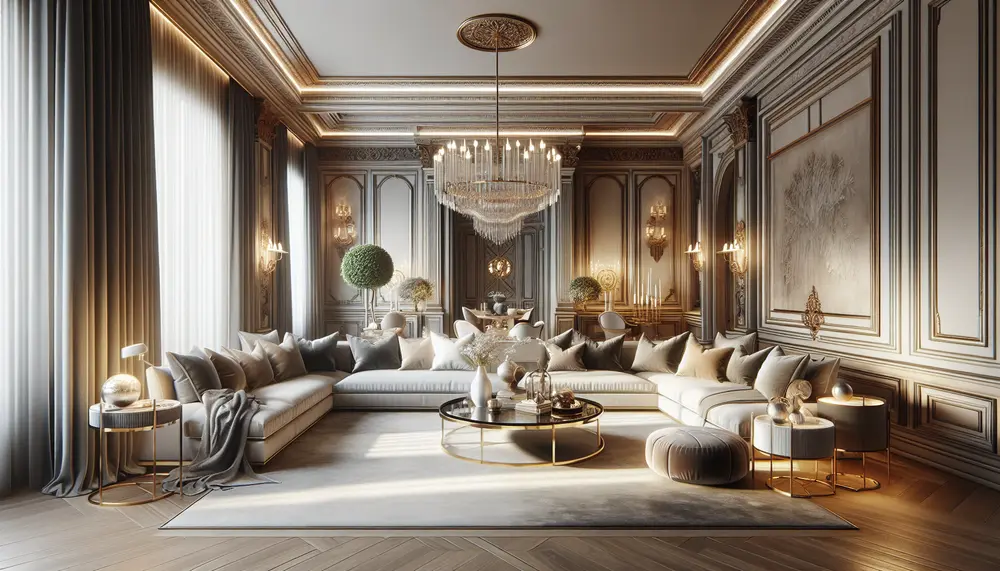Table of Contents:
Introduction to Interior Design Elements
Embarking on the journey of interior design can transform any space from mundane to magnificent. However, to achieve a space that truly reflects personal style and meets practical needs, it's crucial to understand the fundamental elements that form the backbone of design. This includes recognizing how various components like space, color, and texture work together to create a harmonious environment. In this article, we'll delve into the essentials of interior design, offering you valuable insights to craft aesthetically appealing and functional spaces. Whether you're a beginner or looking to refine your design knowledge, the principles we explore will empower you to make informed decisions, turning your design vision into reality.
The Role of Space in Interior Design
Space is the canvas on which all interior design elements come together. It is divided into two segments: positive space, where furniture and decor reside, and negative space, the open areas between them. The balance between these two types of space is key in creating an uncluttered yet dynamic environment. Designing with space in mind involves considering room dimensions, the functionality of the area, and ensuring that there is enough room for movement. An understanding of space helps dictate how to best use the other interior design elements, such as placing furniture or choosing the scale of pieces relative to the room size. In essence, the control and allocation of space is the first step towards achieving aesthetic and practical harmony in any interior design project.
Pros and Cons of Key Interior Design Elements
| Aspect | Pros | Cons |
|---|---|---|
| Color Scheme |
- Sets the mood and atmosphere - Can make spaces feel larger or smaller - Reflects personal style |
- Difficult to change later - Wrong colors can create undesired effects - Color trends can go out of style quickly |
| Lighting |
- Enhances the ambiance - Can highlight architectural features - Energy-efficient options available |
- Can be expensive to install - Poor lighting can negatively affect the space - Complex wiring may be required |
| Space Planning |
- Optimizes the usability of an area - Improves flow and movement - Can accommodate specific lifestyle needs |
- Time-consuming to plan - May require compromising on certain wants - Inflexible layouts can create future issues |
| Materials and Textures |
- Adds depth and interest - Various textures can create unique experiences - Durable materials can last longer |
- High-quality materials can be costly - Some materials require regular maintenance - Textures may become dated over time |
| Furniture Selection |
- Defines the function of the space - Enhances comfort and aesthetics - Can be statement pieces |
- Can be expensive - Size and scale errors can ruin a space - Trendy pieces may need to be replaced often |
Harnessing the Power of Color in Your Space
Color is not just a visual element; it is a powerful tool that can evoke emotions and affect the perceived size and temperature of space. Selecting the right colors can set the mood of a room, from calm and soothing to vibrant and energetic. Understanding color theory is essential when choosing a palette for your space. Complementary colors bring a lively dynamic, while analogous colors create harmony and subtlety. Moreover, the use of a monochromatic scheme can add sophistication and depth. When harnessed correctly, color can be the most transformative of the interior design elements, offering a direct way to personalise your space to reflect your taste and personality.
Form and Function: Shaping Your Interior
Form refers to the shapes present within your space and includes the physical form of the room as well as the objects within it. These shapes can be geometric with clean lines and angles, or they can be organic, adding a natural, more free form aspect to the room. Function, on the other hand, involves designing with the purpose of the space in mind. It's about ensuring that the room not only looks pleasing but also serves its intended use efficiently. In interior design, the marriage of form and function implies that every piece not only adds to the overall aesthetics but also has a purpose, providing both convenience and appeal. This duality is the cornerstone of a well-designed room, ensuring that beauty is met with practicality.
Illuminating Your Space: The Importance of Light
Light, whether natural or artificial, is a critical element in interior design. It has the power to drastically change the ambiance of a room, influence colors, and highlight architectural features. Effective lighting design combines three types: ambient, task, and accent. Ambient lighting provides overall illumination and sets the tone of the space. Task lighting is focused on specific areas to facilitate activities like reading or cooking. Accent lighting is used to draw attention to particular design elements, artwork, or unique architectural details. Choosing the right kind of light fixtures and their placement plays a vital role in enhancing the functionality as well as the mood of the space. Integrating a variety of lighting sources can make a room versatile and adaptive to different occasions and times of the day.
Creating Harmony with Lines and Structure
Lines play a pivotal role in establishing the structural foundation upon which interior design builds. Horizontal lines, exemplified by tables and other surfaces, lend a sense of stability and expansiveness to space. Vertical lines, as seen in doorways and tall windows, evoke feelings of freedom and strength. Diagonal lines create movement and action, often found in staircases, while curved lines add a softening effect, introducing elegance and comfort. The strategic use of lines within a space helps to guide the eye and shape how the room is perceived. By creating harmony with lines, designers can lead the occupant's gaze to focal points or divide spaces effectively, ensuring each area maintains its distinct character within the broader design landscape.
Patterns: Adding Depth and Interest to Interiors
Patterns can serve as a visual treat in any interior space, contributing texture, depth, and personality. They can be bold or subtle, and can be incorporated through wallpapers, textiles, tiles, or even architectural features. Patterns range from geometric configurations, which can create a sense of order, to organic motifs that mimic the asymmetry found in nature. The key to effectively using patterns in interior design is to find a balance that complements the room's other elements. Patterns should align with the color scheme and scale of the space, enhancing without overwhelming. Skillfully mixed patterns add a layer of complexity and intrigue, keeping the eyes engaged and enhancing the room's overall aesthetic appeal.
Texture: The Subtle Touch that Transforms Spaces
Texture is the element of interior design that appeals to our sense of touch, as much as to our eyes. It encompasses the surface quality of a material, be it rough, smooth, soft, or hard. Textures can be introduced through a variety of mediums such as fabrics, woods, metals, stones, and even wall finishes. A room with a mixture of textures will stimulate the senses and can enhance comfort and interest. For example, a velvet sofa adds richness and luxury, while a stone wall can introduce a raw, natural feel to the room. Thoughtful use of texture injects depth into a space and ensures that despite a room's color or pattern, the area remains visually dynamic and layered.
Balancing the Elements for Cohesive Interior Design
Achieving a cohesive interior design calls for a well-considered balance of all design elements. It's about ensuring that space, color, light, form, line, pattern, and texture all work in concert to create a unified and pleasing whole. Harmonizing these elements requires a thoughtful approach to how they interact and contrast with each other. The right balance can lead to a space that feels thoughtfully curated rather than chaotic. It allows for areas of focus without neglecting the importance of functionality. By considering each element's contribution to the overall design, one can craft a space that is not only aesthetically pleasing but also reflects the personal style and meets the practical needs of its inhabitants.
Conclusion: Mastering the Art of Interior Design Elements
Mastering the art of interior design elements is a journey of understanding how different components can be harmonized to create spaces that are both functional and visually captivating. By being mindful of how space can be optimized, how color can influence mood, how light can enhance ambiance, how form and function should be considered in tandem, how lines add structure, how patterns provide depth, and how texture brings life to surfaces, anyone can begin to shape interiors with confidence and creativity. It's this equilibrium between beauty and practicality that defines truly exceptional design. With these fundamental elements in mind, you're now equipped to elevate any space from ordinary to extraordinary.
Top 5 FAQs on Mastering Interior Design Essentials
What is the significance of space in interior design?
Space is the foundation of interior design, serving as the canvas where all elements come together. It's divided into positive space (occupied by furniture and decor) and negative space (the open areas around objects), and the balance of these defines a room's layout, functionality, and movement flow.
How does color affect interior design?
Color is a powerful tool in interior design, influencing the room's mood and the perceived size of spaces. The right color choices can evoke emotions, define the atmosphere, and reflect personal style, making it a transformative element for customization and aesthetic appeal.
Why is lighting important in interior design?
Lighting is essential as it significantly affects the ambiance, highlights architectural features, and influences color perception within a room. It combines ambient, task, and accent lighting to create practical and mood-enhancing environments that are adaptable to different times and activities.
What role does texture play in interior design?
Texture adds depth and interest to a space. It can be visual and tactile, covering surfaces through materials like fabrics, woods, and stones. A mix of textures stimulates the senses, enhances comfort, and ensures a space remains dynamic, regardless of the color scheme or pattern presence.
How do patterns contribute to interior design?
Patterns add visual interest and personality to interiors, through wallpapers, textiles, or architectural features. They range from ordered geometric shapes to natural organic motifs, providing balance and complexity that can enhance the room's overall aesthetic and keep the eye engaged.






